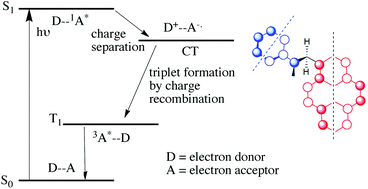当前位置:
X-MOL 学术
›
Photochem. Photobiol. Sci.
›
论文详情
Our official English website, www.x-mol.net, welcomes your feedback! (Note: you will need to create a separate account there.)
Making triplets from photo-generated charges: observations, mechanisms and theory.
Photochemical & Photobiological Sciences ( IF 3.1 ) Pub Date : 2020-01-29 , DOI: 10.1039/c9pp00399a Dáire J Gibbons 1 , Aram Farawar , Paul Mazzella , Stéphanie Leroy-Lhez , René M Williams
Photochemical & Photobiological Sciences ( IF 3.1 ) Pub Date : 2020-01-29 , DOI: 10.1039/c9pp00399a Dáire J Gibbons 1 , Aram Farawar , Paul Mazzella , Stéphanie Leroy-Lhez , René M Williams
Affiliation

|
Triplet formation by charge recombination is a phenomenon that is encountered in many fields of the photo-sciences and can be a detrimental unwanted side effect, but can also be exploited as a useful triplet generation method, for instance in photodynamic therapy. In this Perspective we describe the various aspects that play a role in the decay of charge separated states into local triplet states. The observations and structures of a selection of (pre-2015) molecular electron donor-acceptor systems in which triplet formation by charge recombination occurs are reported. An overview is given of some more recent systems consisting of BODIPY dimers, and BODIPYs attached to various electron-donor units displaying this same triplet formation process. A selection of polymer-fullerene blends in which triplet formation by (non-geminate) charge recombination has been observed, is presented. Furthermore, in-depth information regarding the mechanistic aspects of triplet formation by charge recombination is given on spin dephasing, through hyperfine interactions, as well as on spin-orbit coupling occurring simultaneously with charge recombination. The limits and constraints of these factors and their role in intersystem crossing are discussed. A pictorial view of the two mechanisms is given and this is correlated to aspects of the selection rules for triplet formation, the so-called El-Sayed rules. It is shown that the timescale of triplet formation by charge recombination is indicative for the mechanism that is responsible for the process. The relatively slow rates (CRkT ∼ 1 × 108 s-1 or slower) can be correlated to proton hyperfine interactions (also called the radical pair mechanism), but substantially faster rates (CRkT ∼ 1 × 109 up to 2.5 × 1010 s-1 or faster) have to be correlated to spin-orbit coupling effects. Several examples of molecular systems showing such fast rates are available and their electron donor and acceptor orbitals display an orthogonal relationship with respect to each other. This orientation of (the nodal planes of) the π-orbitals of the donor and acceptor units is correlated to the mechanisms in photodynamic agents and photovoltaic blends.
中文翻译:

用光生电荷制造三胞胎:观察,机理和理论。
通过电荷重组形成三重态是在光科学的许多领域中遇到的现象,并且可能是有害的有害副作用,但是也可以用作有用的三重态产生方法,例如在光动力疗法中。在此透视图中,我们描述了在电荷分离态衰减为局部三重态的过程中起作用的各个方面。报告了选择的(2015年前)分子电子给体-受体系统的观察结果和结构,其中通过电荷重组形成三重态。概述了一些较新的系统,该系统由BODIPY二聚体和连接至各种电子供体单元的BODIPY组成,这些电子供体单元显示出相同的三重态形成过程。提出了聚合物-富勒烯共混物的选择,其中已经观察到通过(非双键)电荷重组形成三重态。此外,在自旋相移,通过超精细相互作用以及与电荷重组同时发生的自旋-轨道耦合方面,给出了有关通过电荷重组形成三重态的机理方面的深入信息。讨论了这些因素的限制和约束及其在系统间交叉中的作用。给出了这两种机制的图示,并且与三元组形成的选择规则(即所谓的El-Sayed规则)的各个方面相关。结果表明,通过电荷重组形成三重态的时间尺度表明了负责该过程的机理。相对较慢的速率(CRkT〜1×108 s-1或更慢)可与质子超精细相互作用(也称为自由基对机理)相关,但速率较快(CRkT〜1×109直至2.5×1010 s-1)或更快)必须与自旋轨道耦合效应相关联。可以显示出表现出如此快的速率的分子系统的几个例子,并且它们的电子给体和受体轨道之间呈现出正交关系。供体和受体单元的π轨道(的节点平面)的这种取向与光动力剂和光伏混合物的机理相关。可以显示出表现出如此快的速率的分子系统的几个例子,并且它们的电子给体和受体轨道之间呈现出正交关系。供体和受体单元的π轨道(的节点平面)的这种取向与光动力剂和光伏混合物的机理相关。可以显示出表现出如此快的速率的分子系统的几个例子,并且它们的电子给体和受体轨道之间呈现出正交关系。供体和受体单元的π轨道(的节点平面)的这种取向与光动力剂和光伏混合物的机理相关。
更新日期:2020-02-19
中文翻译:

用光生电荷制造三胞胎:观察,机理和理论。
通过电荷重组形成三重态是在光科学的许多领域中遇到的现象,并且可能是有害的有害副作用,但是也可以用作有用的三重态产生方法,例如在光动力疗法中。在此透视图中,我们描述了在电荷分离态衰减为局部三重态的过程中起作用的各个方面。报告了选择的(2015年前)分子电子给体-受体系统的观察结果和结构,其中通过电荷重组形成三重态。概述了一些较新的系统,该系统由BODIPY二聚体和连接至各种电子供体单元的BODIPY组成,这些电子供体单元显示出相同的三重态形成过程。提出了聚合物-富勒烯共混物的选择,其中已经观察到通过(非双键)电荷重组形成三重态。此外,在自旋相移,通过超精细相互作用以及与电荷重组同时发生的自旋-轨道耦合方面,给出了有关通过电荷重组形成三重态的机理方面的深入信息。讨论了这些因素的限制和约束及其在系统间交叉中的作用。给出了这两种机制的图示,并且与三元组形成的选择规则(即所谓的El-Sayed规则)的各个方面相关。结果表明,通过电荷重组形成三重态的时间尺度表明了负责该过程的机理。相对较慢的速率(CRkT〜1×108 s-1或更慢)可与质子超精细相互作用(也称为自由基对机理)相关,但速率较快(CRkT〜1×109直至2.5×1010 s-1)或更快)必须与自旋轨道耦合效应相关联。可以显示出表现出如此快的速率的分子系统的几个例子,并且它们的电子给体和受体轨道之间呈现出正交关系。供体和受体单元的π轨道(的节点平面)的这种取向与光动力剂和光伏混合物的机理相关。可以显示出表现出如此快的速率的分子系统的几个例子,并且它们的电子给体和受体轨道之间呈现出正交关系。供体和受体单元的π轨道(的节点平面)的这种取向与光动力剂和光伏混合物的机理相关。可以显示出表现出如此快的速率的分子系统的几个例子,并且它们的电子给体和受体轨道之间呈现出正交关系。供体和受体单元的π轨道(的节点平面)的这种取向与光动力剂和光伏混合物的机理相关。



























 京公网安备 11010802027423号
京公网安备 11010802027423号